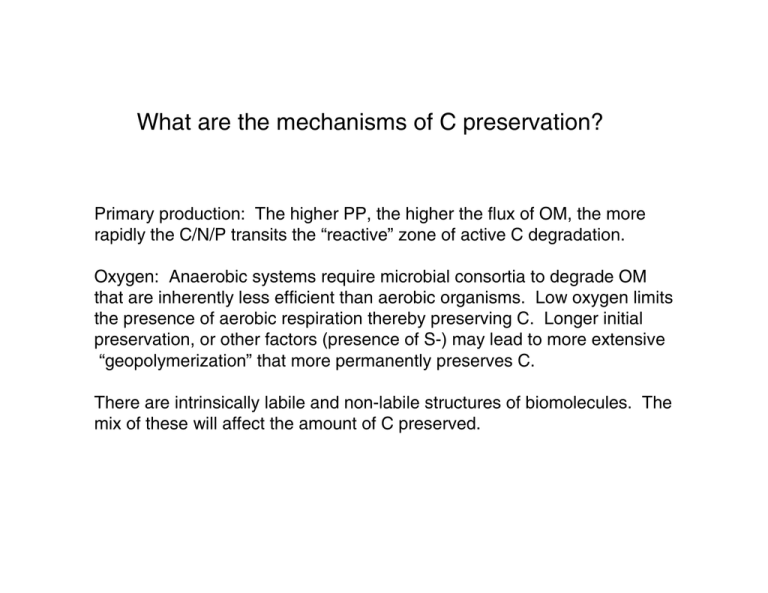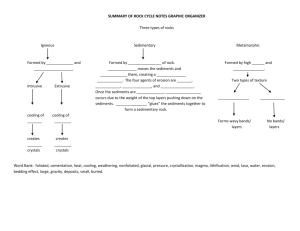What are the mechanisms of C preservation?
advertisement

What are the mechanisms of C preservation? Primary production: The higher PP, the higher the flux of OM, the more rapidly the C/N/P transits the “reactive” zone of active C degradation. Oxygen: Anaerobic systems require microbial consortia to degrade OM that are inherently less efficient than aerobic organisms. Low oxygen limits the presence of aerobic respiration thereby preserving C. Longer initial preservation, or other factors (presence of S-) may lead to more extensive “geopolymerization” that more permanently preserves C. There are intrinsically labile and non-labile structures of biomolecules. The mix of these will affect the amount of C preserved. If you want to understand why C is preserved in marine sediments, look at where it is buried…. Figure by MIT OCW. Tabulation of C burial in marine sediments Organic Carbon Burial Rates (and percentages) in Different Ocean Regimes Sediment type Deltaic Shelf Slope Pelagic Total Data from Gershanovich et al. (1974) All sediment types 0 (0) 23 (10) 195 (88) 5 (2) 223 e = 223 Data from Berner (1989) Terrigenous deltaic-shelf sediments Biogenous sediments (high-productivity zones) Shallow-water carbonates Pelagic sediments (low-productivity zones) Anoxic basins (e.g. Black Sea) 104 (82) 0 0 0 0 0 0 6 (5) 0 1 (1) 0 7 (6) 0 0 0 0 3 (2) 0 5 (4) 0 104 10 6 5 1 S = 126 Recalculation of data from Berner (1989) Deltaic sediments Shelves and upper slopes Biogenous sediments (high-productivity zones) Shallow-water carbonates Pelagic sediments (low-productivity zones) Anoxic basins (e.g. Black Sea) 70 (44) 0 0 0 0 0 0 68 (42) 0 6 (4) 0 1 (0.5) 0 0 7 (4) 0 0 0 3 (2) 0 5 (3) 0 70 68 10 6 5 1 S = 160 Units are 1012 gCyr-1 (parenthetical units = percent of total burial). *Deltaic-shelf sediments were reapportioned assuming that 33% of the sediment discharge from rivers is deposited either along non-delatic shelves or upper slopes, and assuming that those deposits have total loadings of 1.5% organic carbon rather than 0.7% as in delatic regions. Estimate for all other regions remain the same. Figure by MIT OCW. Protection and preservation of C on mineral surfaces Larry Mayer and others reasoned that there is no such thing as a naked mineral surface in seawater. Further, the amount of C that can be loaded onto a sediment particle is proportional to its surface area. weathering adsorption Organic carbon vs surface area for sediments from the Gulf of Maine Organic carbon vs surface area for sediments from the Gulf of Maine m = 0.57 mg C m-2 Organic carbon vs surface area for sediments from the Gulf of Maine Monolayer equivalent (ME) loading m = 0.57 mg C m-2 Surfaces are coated with organic matter to the equivalent of one molecule thick… Sediments may be overloaded with C due to biogeochemical cycling, but eventually diagenesis will reduce the C load to a set surface area vs %OC value Mineral surface area vs %organic carbon for Columbia River Sediments (Hedges and Keil, Mar. Chem (1995) 49, 81-115.) Surface area vs %organic carbon for sediments from low oxygen depositional regimes m = 2.5 mg C m-2 Surface area vs % organic carbon for Equatorial Pacific sediments Surface area vs % organic carbon for deltaic and river sediments Proposed mechanism for surface protection adsorption of organic matter into very small pores enzymes Surface area control on OC preservation in marine sediment.. Weathering introduces new mineral surfaces constantly to the environment. These surfaces ultimately become coated with organic matter, at approximately a monolayer equivalent loading. Under conditions that are typical for sediment deposition on continental margins (where most C is buried) degradation proceeds to the ME loading and slows sufficiently there after to preserve this amount of carbon. In open ocean setting, where oxygen exposure times are much longer, degradation proceeds to < ME loadings. In anoxic basins, where oxygen exposure times are much shorter, loadings are > ME. Mechanism is preservation in small pores that are inaccessible to enzymes. e.g. physical protection. What is the problem with this model??? Hint……think of the δ13C of marine sediments. weathering adsorption The rebuttal to surface area control on OC preservation…… Theoretical surface area of a 1 mm pitted spherical particle It is impossible to physically protect that much organic matter in pits & cracks Ransom et al., GCA (1998) 62, 1329-1345 Effect of high surface area material on total surface area Ransom et al., GCA (1998) 62, 1329-1345 Mineral surface area vs %organic carbon for Columbia River Sediments (Hedges and Keil, Mar. Chem (1995) 49, 81-115.) Surface area vs %TOC in Washington margin sediments (Keil et al, (1994) GCA, 58, 879-893. Grain size, smectite, opal, and surface area in Washington margin sediments Ransom et al., GCA (1998) 62, 1329-1345 Correlation of surface area, TOC, Clay minerals+opal in Washington margin sediments Ransom et al., GCA (1998) 62, 1329-1345 TOC vs surface are for California margin sediments Ransom et al., GCA (1998) 62, 1329-1345 Correlation of clay minerals with TOC in coastal sediments Ransom et al., GCA (1998) 62, 1329-1345 Correlation of clay minerals with TOC in coastal sediments SLO clays 21-29% smectite 0-3% chlorite Semectite rich clays NM clays 3-13% smectite 13-24% chlorite Chlorite rich clay Clay mineralogy, not simple surface area drives OC preservation Ransom et al., GCA (1998) 62, 1329-1345 Semectite rich clays Chlorite rich clay …..and finally the mechanism of preservation…. Mayer-Hedges-Keil hypothesis Physical protection from enzymatic degradation in small pores/cracks Ransom hypothesis No physical protection OM is on surface and only a small fraction is in contact with mineral. Things to remember….. Most OM is preserved in continental margin sediments Carbon loading is proportional to surface area Sedimentation rate, or rate of burial may be a factor Effect of oxygen is open, some evoke it, some do not. not clear if or how it is a factor. Mechanism of C preservation is also open. Physical protection has been argued, but how this works may not be understood.






